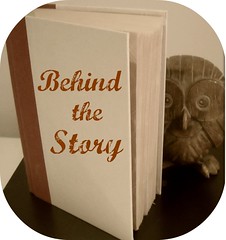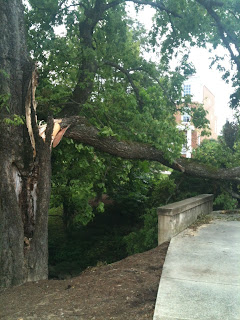 Behind the Story posts will be about what goes on behind the scenes as a writer creates their story. I'll be writing about my own writing process and sharing any tips or advice I've discovered on my own or gathered on the topic. Hopefully both readers and writers find these posts fascinating!
Behind the Story posts will be about what goes on behind the scenes as a writer creates their story. I'll be writing about my own writing process and sharing any tips or advice I've discovered on my own or gathered on the topic. Hopefully both readers and writers find these posts fascinating!This week's topic:
Being Evil to Your Characters
Why would you want to be evil to your own creations?
- To provide challenges and conflict
- To create compelling characters who grow over the course of the story through the challenges they face
- For suspense and pacing
- As a plotting tool
This is one of those pieces of advice or writing tips that I don’t remember where I heard it. But it really resonated with me, and is one of the first things I do when plotting a section of a novel. I think it is a really, really valuable technique if you struggle with pacing, plotting, or giving characters agency.
Quotes About Being Tough on Your Characters
Editor, Cheryl Klein, Arthur A. Levine Books
Ten Ways to Create Compelling Characters
#6 Put the character in pain, danger, or jeopardy (anticipated pain)
Author, Kurt Vonnegut
8 Basics of Creative Writing
#6: Be a sadist. No matter how sweet and innocent your leading characters, make awful things happen to them—in order that the reader may see what they are made of.
Author, Maggie Stiefvater
Blog Post: Bringing Out Your Inner Sadist
“I have decided that in order to be a good writer, you have to be a sadist.”
“And that’s when I decided that I must have an inner sadist in there somewhere. Because although I love my characters dearly, I have to say, I also love to hurt them. I love to take away the stuff they need and the people they love and shove them outside their comfort zone without so much as a windbreaker. I like to make them uncomfortable, humiliate them, gun down their loved ones in cold blood, and give them pasts that will haunt them forever.”
“I think part of it is because of that saying: ‘Women are like tea bags. You never know how strong they are until they’re in hot water.’ Characters are like women which are like tea bags. You can learn a bit about them when things are going well, but it’s not until the proverbial poo hits the proverbial fan and plagues are raining down that you really see what sort of a person they are.”
“So I guess I figure that if a little pain and suffering will show me more about them, a lot of pain and suffering will do it even better. Basically, as soon as a character lets on what their worst fear is, it’s a pretty surefire sign that I am going to make them come face to face with it at some point in the novel. “
“I don't think readers like it when you are nice to the characters. They think they want characters to be happy, but they don't really. At least not until the characters have first been really miserable. I think a good writer finds their characters’ monsters and then resurrects them at the worst possible moment, and that we readers, like Jerry Springer audience members, love the angst and drama of it.”
Author, Janet Fitch
10 Rules for Writers
#10 Torture your protagonist. The writer is both a sadist and a masochist. We create people we love, and then we torture them. The more we love them, and the more cleverly we torture them along the lines of their greatest vulnerability and fear, the better the story. Sometimes we try to protect them from getting booboos that are too big. Don’t. This is your protagonist, not your kid.
The 22 rules of storytelling, according to Pixar:
#1: You admire a character for trying more than for their successes.
#6: What is your character good at, comfortable with? Throw the polar opposite at them. Challenge them. How do they deal?
#16: What are the stakes? Give us reason to root for the character. What happens if they don't succeed? Stack the odds against.
#19: Coincidences to get characters into trouble are great; coincidences to get them out of it are cheating.
Ari Susu-Mago at blog “A Fuzzy Mango With Wings”
Blog Post: The Sadism of Fiction
(or, What Game of Thrones Can Teach Us About Writing)
“He makes likable, interesting, flawed, human characters. And then he makes their lives suck.”Examples of Author Sadism:
“Moreover, note that not only does he make problems for them right at the beginning of the story, but he makes things get worse all the time. Rarely, if ever, do things get better. Plans go awry. People turn traitor. People get angry and say things they shouldn’t. People get killed. In general, more problems crop up. The result? A 800+ page book that flies by.”
Harry Potter and the Sorceror’s Stone by JK Rowling
How bad did JK Rowling make Harry’s aunt and uncle?
Rowling made them about as terrible as aunts/uncles can get.
How did the Dursleys keep Harry from his Hogwarts’ letter?
Rowling didn't just hold Harry back from reading the letter, she took it to extreme levels by the Dursleys trying to hide on a rock in the middle of the sea. By throwing so many obstacles in Harry's path to reading the letter, it made us more invested in the story and increases suspense and tension.
Ender’s Game by Orson Scott Card
Everytime Ender became comfortable, Card threw him into a new challenge or worse situation.
Example:
Ender makes friends in his launch group and starts to be successful at the Battle School.
But then he is moved to Salamander Army where he is the smallest and most inexperienced, and Bonzo won’t even let him practice.
Downton Abbey
They make the audience care...
Then very briefly give them a glimpse of what they want...
Then they ruin or take it away...
(Examples: Anna/Bates or Matthew/Mary)
The Way I Incorporate this Technique in My Own Writing
Usually at the start of a work (or at the start of a new setting) I brainstorm a list of things that could go wrong either in the story or in that particular setting.
The list forces me to think of things that could go wrong and sets my brain thinking in that direction. And I have a resource to refer to later if I need to.
When I sit down to start writing, I try to begin a chapter by resolving a previous problem or setting the stage for a new problem.
I try to always end a chapter in the midst of a low point for the protagonist. It can be a physical low point or an emotional low point.
Writing Exercise:
Brainstorm a list:
- Of things that could get in your protagonist’s way of their goal.
- Of terrible things that could happen to your protagonist.
- Of characters your protagonist needs in their life, and how they could disappear.
Don’t worry about how your character will get out of it, or how they’ll overcome it.
Don’t worry about how it will fit into your plot.
Don’t worry about how extreme it might be.
Links Quoted in this Post:
Maggie Stiefvater, Blog Post: Bringing Out Your Inner Sadist
http://m-stiefvater.livejournal.com/103969.html
Maggie Stiefvater, Collection of Posts on Writing
http://m-stiefvater.livejournal.com/214290.html
Kurt Vonnegut’s 8 Basics of Creative Writing
http://www.writingclasses.com/InformationPages/index.php/PageID/538/
Janet Fitch’s 10 Rules for Writers
http://latimesblogs.latimes.com/jacketcopy/2010/07/janet-fitchs-10-rules-for-writers.html
The 22 Rules of Storytelling According to Pixar
http://io9.com/5916970/the-22-rules-of-storytelling-according-to-pixar
Blog Post: The Sadism of Fiction
(or, What Game of Thrones Can Teach Us About Writing)
http://fuzzymango.wordpress.com/2012/06/17/the-sadism-of-fiction-or-what-game-of-thrones-can-teach-us-about-writing/
Ava Jae, of “Writablity: Tips, Tricks and Thoughts from One Writer to Cyberspace”
http://avajae.blogspot.com/2012/01/every-writer-should-be-sadist.html






